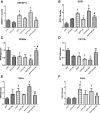Allopurinol ameliorates high fructose diet induced hepatic steatosis in diabetic rats through modulation of lipid metabolism, inflammation, and ER stress pathway
- PMID: 33972568
- PMCID: PMC8110790
- DOI: 10.1038/s41598-021-88872-7
Allopurinol ameliorates high fructose diet induced hepatic steatosis in diabetic rats through modulation of lipid metabolism, inflammation, and ER stress pathway
Abstract
Excess fructose consumption contributes to development obesity, metabolic syndrome, and nonalcoholic fatty liver disease (NAFLD). Uric acid (UA), a metabolite of fructose metabolism, may have a direct role in development of NAFLD, with unclear mechanism. This study aimed to evaluate role of fructose and UA in NAFLD and explore mechanisms of allopurinol (Allo, a UA lowering medication) on NAFLD in Otsuka Long-Evans Tokushima Fatty (OLETF) rats fed a high fructose diet (HFrD), with Long-Evans Tokushima Otsuka (LETO) rats used as a control. There were six groups: LETO, LETO-Allo, OLETF, OLETF-Allo, OLETF-HFrD, and OLETF-HFrD-Allo. HFrD significantly increased body weight, epididymal fat weight, and serum concentrations of UA, cholesterol, triglyceride, HbA1c, hepatic enzymes, HOMA-IR, fasting insulin, and two hour-glucose after intraperitoneal glucose tolerance tests, as well as NAFLD activity score of liver, compared to the OLETF group. Allopurinol treatment significantly reduced hepatic steatosis, epididymal fat, serum UA, HOMA-IR, hepatic enzyme levels, and cholesterol in the OLETF-HFrD-Allo group. Additionally, allopurinol significantly downregulated expression of lipogenic genes, upregulated lipid oxidation genes, downregulated hepatic pro-inflammatory cytokine genes, and decreased ER-stress induced protein expression, in comparison with the OLETF-HFrD group. In conclusion, allopurinol ameliorates HFrD-induced hepatic steatosis through modulation of hepatic lipid metabolism, inflammation, and ER stress pathway. UA may have a direct role in development of fructose-induced hepatic steatosis, and allopurinol could be a candidate for prevention or treatment of NAFLD.
Conflict of interest statement
The authors declare no competing interests.
Figures




Similar articles
-
Alcohol-induced increase in BMP levels promotes fatty liver disease in male prediabetic stage Otsuka Long-Evans Tokushima Fatty rats.J Cell Biochem. 2023 Mar;124(3):459-472. doi: 10.1002/jcb.30385. Epub 2023 Feb 15. J Cell Biochem. 2023. PMID: 36791312
-
Reduced hepatic eNOS phosphorylation is associated with NAFLD and type 2 diabetes progression and is prevented by daily exercise in hyperphagic OLETF rats.J Appl Physiol (1985). 2014 May 1;116(9):1156-64. doi: 10.1152/japplphysiol.01275.2013. Epub 2014 Feb 27. J Appl Physiol (1985). 2014. PMID: 24577062 Free PMC article.
-
Rare sugar D-psicose improves insulin sensitivity and glucose tolerance in type 2 diabetes Otsuka Long-Evans Tokushima Fatty (OLETF) rats.Biochem Biophys Res Commun. 2011 Feb 4;405(1):7-12. doi: 10.1016/j.bbrc.2010.12.091. Epub 2010 Dec 25. Biochem Biophys Res Commun. 2011. PMID: 21187061
-
Fructose as a key player in the development of fatty liver disease.World J Gastroenterol. 2013 Feb 28;19(8):1166-72. doi: 10.3748/wjg.v19.i8.1166. World J Gastroenterol. 2013. PMID: 23482247 Free PMC article. Review.
-
Fructose-mediated effects on gene expression and epigenetic mechanisms associated with NAFLD pathogenesis.Cell Mol Life Sci. 2020 Jun;77(11):2079-2090. doi: 10.1007/s00018-019-03390-0. Cell Mol Life Sci. 2020. PMID: 31760464 Free PMC article. Review.
Cited by
-
Sestrin2: multifaceted functions, molecular basis, and its implications in liver diseases.Cell Death Dis. 2023 Feb 25;14(2):160. doi: 10.1038/s41419-023-05669-4. Cell Death Dis. 2023. PMID: 36841824 Free PMC article. Review.
-
A Possible Therapeutic Application of the Selective Inhibitor of Urate Transporter 1, Dotinurad, for Metabolic Syndrome, Chronic Kidney Disease, and Cardiovascular Disease.Cells. 2024 Mar 4;13(5):450. doi: 10.3390/cells13050450. Cells. 2024. PMID: 38474414 Free PMC article. Review.
-
Convergence of Fructose-Induced NLRP3 Activation with Oxidative Stress and ER Stress Leading to Hepatic Steatosis.Inflammation. 2023 Feb;46(1):217-233. doi: 10.1007/s10753-022-01727-9. Epub 2022 Aug 9. Inflammation. 2023. PMID: 35941320
-
THE THERAPEUTIC EFFECT OF ALLOPURINOL IN FATTY LIVER DISEASE IN RATS.Acta Endocrinol (Buchar). 2023 Apr-Jun;19(2):155-162. doi: 10.4183/aeb.2023.155. Epub 2023 Oct 27. Acta Endocrinol (Buchar). 2023. PMID: 37908883 Free PMC article.
-
Diosgenin Ameliorated Type II Diabetes-Associated Nonalcoholic Fatty Liver Disease through Inhibiting De Novo Lipogenesis and Improving Fatty Acid Oxidation and Mitochondrial Function in Rats.Nutrients. 2022 Nov 24;14(23):4994. doi: 10.3390/nu14234994. Nutrients. 2022. PMID: 36501024 Free PMC article.
References
Publication types
MeSH terms
Substances
LinkOut - more resources
Full Text Sources
Other Literature Sources
Medical

